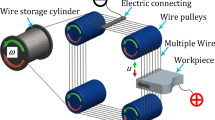Abstract
High-aspect ratio microstructures made of stainless steel 304 have found its extensive applications in the microsystem industry. Using a nanosecond pulse generator, high-aspect ratio components can be obtained by wire electrochemical micromachining (WEMM). Mass transport is substantially vital in WEMM to achieve high aspect ratio. Combining traveling and vibrating anode can effectively improve mass transport and consequently enhances machining result. When workpieces become thicker, mass transport would get worse. Many researchers have investigated the fabrication of microstructures on 304SS plate with thickness of 100 μm using WEMM. However, not enough attention has been paid to the machining of microstructures on 304SS plates with thickness of more than 100 μm which is an alternative to obtain high aspect ratio. Moreover, the parameters used for 100-μm-thick 304SS are not suitable for thicker 304SS. Therefore, it is necessary to investigate the fabrication of high-aspect ratio microstructures on 304SS plates with thickness of more than 100 μm. In this work, the machining of micro slits on 270-μm-thick 304SS plates by WEMM was investigated. A combination of traveling wire and vibrating anode was also employed to enhance mass transfer. The effects of traveling wire parameters and vibrating anode parameters on the slit width and slit profile were researched. Experimental results show that the stroke and traveling speed of the traveling wire together with frequency and amplitude of the vibrating anode for 270-μm-thick 304SS plates are higher than those for 100-μm-thick 304SS plates. The average slit width machined with optimized parameters using WEMM is 26 μm and the standard deviation is about 1.3. In the meantime, the slit profile is smooth, and the average aspect ratio is about 10.
Similar content being viewed by others
References
Becker H, Heim U (2000) Hot embossing as a method for the fabrication of polymer high aspect ratio structures. Sensors Actuators A Phys 83(1–3):130–135
Chanpark MB, Yan Y, Neo WK, Zhou WX, Zhang J, Yue CY (2003) Fabrication of high aspect ratio poly (ethylene glycol)-containing microstructures by UV embossing. Langmuir 19(10):4371–4380
Koh WG, Revzin A, Pishko MV (2002) Poly (ethylene glycol) hydrogel microstructures encapsulating living cells. Langmuir 18(7):2459–2462
Chamran F, Yeh Y, Min HS, Dunn B, Kim CJ (2007) Fabrication of high-aspect-ratio electrode arrays for three-dimensional microbatteries. J Microelectromech Syst 16(4):844–852
Natarajan N, Suresh P (2015) Experimental investigations on the micro hole machining of 304 stainless steel by micro-EDM process using RC-type pulse generator. Int J Adv Manuf Technol 77(9–12):1741–1750
Ayyappan S, Sivakumar K (2016) Enhancing the performance of electrochemical machining of 20MnCr5 alloy steel and optimization of process parameters by PSO-DF optimizer. Int J Adv Manuf Technol 82(9–12):2053–2064
Liu Y, Zhu D, Zeng YB, Huang SY, Yu HB (2010) Experimental investigation on complex structures machining by electrochemical micromachining technology. Chin J Aeronaut 23(5):578–584
He HD, Qu NS, Zeng YB, Yao YY (2017) Enhancement of mass transport in wire electrochemical micro-machining by using a micro-wire with surface microstructures. Int J Adv Manuf Technol 89:3177–3186
Schuster R, Kirchner VV, Allongue P, Ertl G (2000) Electrochemical micromachining. Science (New York NY) 289(5476):98–101
Yu Q, Zeng YB, Xu K, Qu NS, Zhu D (2014) Research on anode vibration and wire electrode travelling in micro wire electrochemical machining. China Mech Eng 25(3):295–299
Xu K, Zeng Y, Li P, Fang XL, Zhu D (2016) Effect of wire cathode surface hydrophilia when using a travelling wire in wire electrochemical micro machining. J Mater Process Technol 235:68–74
Zeng YB, Yu Q, Wang SH, Zhu D (2012) Enhancement of mass transport in micro wire electrochemical machining. CIRP Ann Manuf Technol 61(1):195–198
Wang SH, Zhu D, Zeng YB, Liu Y (2011) Micro wire electrode electrochemical cutting with low frequency and small amplitude tool vibration. Int J Adv Manuf Technol 53(5–8):535–544
Xu K, Zeng YB, Li P, Zhu D (2015) Study of surface roughness in wire electrochemical micro machining. J Mater Process Technol 222:103–109
Zhu D, Wang K, Qu NS (2007) Micro wire electrochemical cutting by using in situ fabricated wire electrode. CIRP Ann Manuf Technol 56(1):241–244
He HD, Zeng YB, Qu NS (2016) An investigation into wire electrochemical micro machining of pure tungsten. Precis Eng 45:285–291
Funding
This project was supported by the National Natural Science Foundation of China (grant no. 51675274) and the Fundamental Research Funds for the Central Universities (grant no. NZ2016106).
Author information
Authors and Affiliations
Corresponding author
Rights and permissions
About this article
Cite this article
Gao, C., Qu, N. Wire electrochemical micromachining of high-aspect ratio microstructures on stainless steel 304 with 270-μm thickness. Int J Adv Manuf Technol 100, 263–272 (2019). https://doi.org/10.1007/s00170-018-2725-z
Received:
Accepted:
Published:
Issue Date:
DOI: https://doi.org/10.1007/s00170-018-2725-z



